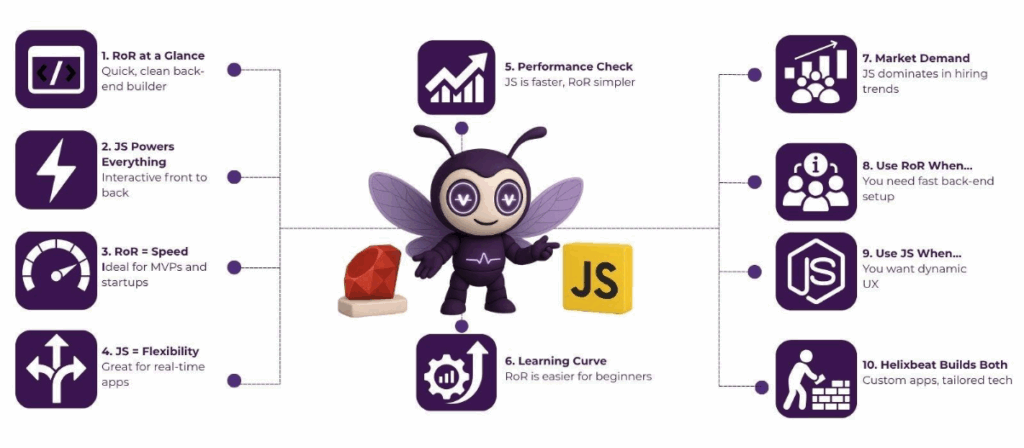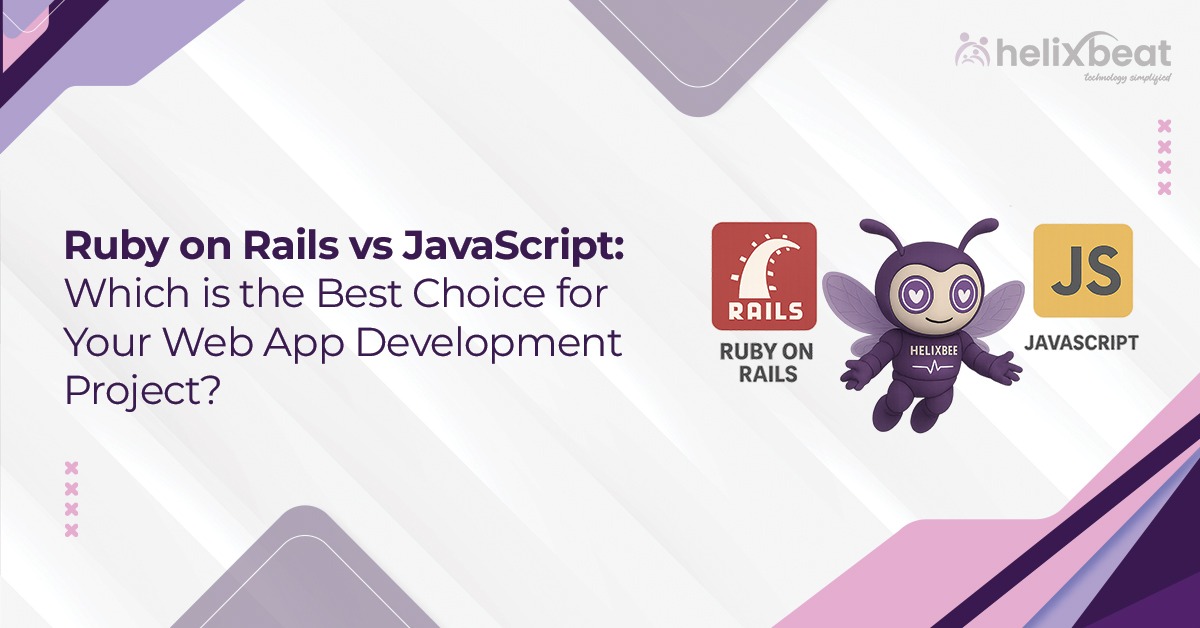Did you know that JavaScript is used on over 97% of websites, making it the backbone of web development today? In contrast, Ruby on Rails is used by fewer but still highly successful startups and companies. For example, Basecamp was built using Ruby on Rails for its speed and simplicity, while Netflix chose JavaScript for its real-time user interaction and dynamic features.
The choice between Ruby on Rails vs JavaScript depends on what your project needs: quick development, interactivity, or scalability. Here, we will explain both technologies, exploring their strengths, when to use them, and which one might be the better fit for your web app development needs. By the end, you’ll have a clearer picture of which framework will best support your goals.

Table of Contents
What is Ruby on Rails and How Does it Work?
Ruby on Rails (RoR) is a full-stack web development framework that emphasizes speed and simplicity. By following convention over configuration, it eliminates repetitive coding tasks, allowing developers to focus on building features.
Rails uses Active Record for database management, ActionView for handling views, and Action Controller for routing, all working together seamlessly. It also promotes the DRY (Don’t Repeat Yourself) principle for cleaner code. Ruby on Rails is ideal for quickly developing scalable applications, making it a go-to choice for startups and MVPs needing fast, efficient development.
Role of JavaScript in Web Development
JavaScript is the core scripting language that powers the interactive elements of modern web development. It allows developers to create dynamic and responsive user interfaces by enabling real-time updates, handling user interactions, and manipulating HTML and CSS on the fly.
JavaScript is used across both the front-end and back-end (via Node.js), making it a versatile choice for full-stack development. It supports asynchronous programming, allowing for smooth, non-blocking interactions like AJAX requests and real-time data updates without reloading the page.
Popular frameworks like React, Angular, and Vue extend JavaScript’s capabilities, helping developers build scalable, maintainable web applications that deliver rich, dynamic user experiences.
Ruby on Rails vs JavaScript: A Side-by-Side Comparison
When comparing Ruby on Rails vs JavaScript, both technologies offer distinct advantages depending on the type of web application you’re building.
Here’s a side-by-side comparison to help you understand their strengths and use cases.
| Feature | Ruby on Rails | JavaScript |
| Primary Use | Back-end web development | Full-stack development (Front-end & Back-end) |
| Speed of Development | Fast development, great for MVPs and startups | Flexible, but may take longer for large-scale apps |
| Learning Curve | Easier for beginners due to convention-based structure | Steeper for beginners due to versatility and complexity |
| Performance | Slower compared to JavaScript, especially for high-concurrency apps | Faster, especially with Node.js for server-side applications |
| Community & Ecosystem | Strong community, great libraries (gems), and support for rapid prototyping | Massive community, rich ecosystem, and used in nearly every web development project |
Which Is in Higher Demand: Ruby on Rails or JavaScript?
Ruby on Rails: Demand and Niche Appeal
Ruby on Rails is popular for building quick, efficient websites, especially for startups creating MVPs (minimum viable products). It’s great for projects that need fast development with clean code, but its demand is smaller compared to JavaScript.
Most companies use Ruby on Rails for the back-end, which limits its use. While there’s steady demand for Rails developers, it’s more niche and typically focused on specific types of projects.
JavaScript: Unmatched Popularity and Versatility
JavaScript is in huge demand because it’s used for both the front-end (what users see) and back-end (server-side logic) of websites. With tools like React, Vue, and Node.js, JavaScript can handle everything from building interactive user interfaces to managing servers.
Because it works across all parts of web development and is essential for creating dynamic, real-time applications, JavaScript is far more popular and in higher demand than Ruby on Rails.
Ruby on Rails vs JavaScript: What’s the Right Choice for Your Project?
Choosing between Ruby on Rails and JavaScript depends on the specific needs of your project. Both frameworks offer unique advantages, and understanding their strengths can help you make the best decision for your development goals.
When to Choose Ruby on Rails
Ruby on Rails is ideal for projects that need fast development with minimal overhead. It’s perfect for building MVPs, startups, or rapid prototypes that require a quick turnaround.
Rails simplifies back-end development and comes with many built-in features, making it easier to scale your application as you grow. If your focus is on a solid, quick back-end setup without heavy front-end interactivity, Ruby on Rails is the right choice.
When to Choose JavaScript
JavaScript is the go-to solution for projects that require real-time interactivity and dynamic user interfaces. If you’re building an application where user engagement, real-time updates, or complex client-side interactions are crucial, JavaScript (with frameworks like React, Node.js, or Vue) is the best option.
It’s also great for full-stack development, allowing developers to manage both the front-end and back-end with a single language, offering more flexibility and scalability.
Hiring Costs: Ruby on Rails vs JavaScript
The cost of hiring developers varies based on their skill set, experience, and geographic location. Below is an estimated comparison of JavaScript and Ruby on Rails developer salaries, which can help you understand the potential costs for your project.
| Role | JavaScript Developer (Annual Salary) | Ruby on Rails Developer (Annual Salary) |
| Junior Developer | $50,000 – $70,000 | $45,000 – $65,000 |
| Mid-Level Developer | $70,000 – $100,000 | $65,000 – $90,000 |
| Senior Developer | $100,000 – $150,000 | $90,000 – $130,000 |
| Freelance Rate (Hourly) | $40 – $80 per hour | $35 – $75 per hour |
Note: These salary estimates reflect U.S.-based rates and may vary depending on the developer’s location and skill level.
Custom Web App Development Services by Helixbeat
At Helixbeat, we specialize in creating custom web applications that are tailored to your unique business needs. Our team of expert developers works closely with you to understand your goals and deliver a solution that drives growth, enhances user experience, and improves operational efficiency.
We focus on building scalable, secure, and high-performance web apps using the latest technologies and frameworks. Whether you need a simple website or a complex enterprise solution, our approach ensures that your application is responsive, intuitive, and capable of adapting to your business as it grows.
With Helixbeat, you get a reliable partner for end-to-end web app development, from concept to deployment. Contact us now for custom web development.
FAQ:
1. What are the advantages of Ruby on Rails for developers?
Ruby on Rails offers rapid development, clean code with the DRY principle, and built-in tools for handling authentication, routing, and database management, making it ideal for quick MVPs and scalable applications.
2. What are the best JavaScript frameworks for web development?
Top JavaScript frameworks include React (for dynamic UIs), Angular (full front-end framework), Vue.js (lightweight and flexible), and Node.js (server-side development).
3. Is Ruby on Rails a dying language?
No, Ruby on Rails remains a strong choice for startups and rapid development, thanks to its speed, built-in features, and large community support.
4. Which is faster, Ruby or JavaScript?
JavaScript is generally faster, especially for real-time applications, due to its non-blocking, event-driven architecture, while Ruby is slower but excels in development speed with Rails.
5. Will Ruby on Rails replace JavaScript?
No, Ruby on Rails and JavaScript serve different roles. Ruby on Rails is mainly used for back-end development, while JavaScript is essential for both front-end and back-end tasks. They often complement each other.














